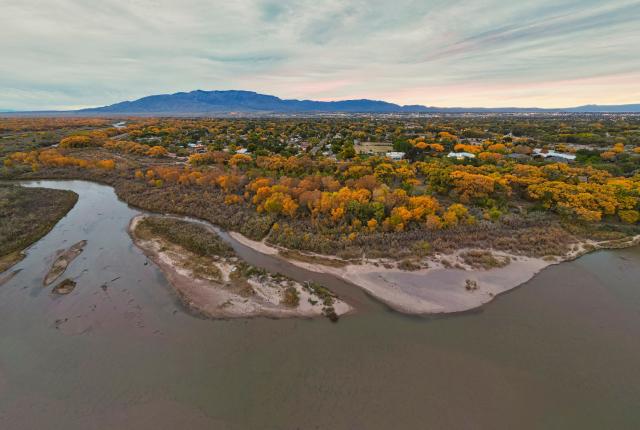AS IT TUMBLES ACROSS the Colorado state line into New Mexico, the Río Grande nourishes a forested garden running the length of the state. Seen from above, as thousands of migrating birds do every autumn, the bosque’s cottonwood leaves glimmer like a slender necklace of copper and gold harboring an environment more precious than any metal.
The splendor attracts paddlers, bikers, runners, walkers, equestrians, and birders, nowhere more so than in the state’s most populated region. Certified arborist Joran Viers ambles on a leaf-coated path near the Río Grande Nature Center State Park, his long legs passing bunches of purple asters and ruddy three-leaf sumacs. He pauses when the trees part and a view opens to the river.
“The bosque is kind of the remnant wild forest we once had,” he says. When he says “had,” Viers means centuries ago.
Ancestral Puebloans and, later, Spanish colonists surely admired the shade of the cottonwood canopy, but it’s possible that the forest primeval also held a variety of oak trees so suitable for firewood that they were quickly cleared out. “We humans tend to not see change over time,” Viers says. “But we’re in a time now where tremendous ecological change is happening.”
Before setting up a tree-care and urban-forestry business this past winter, Viers served as the City of Albuquerque’s chief forester, which meant he constantly assessed the health of the city’s treescape. He could chart its ecological change in part by the bosque’s increasing numbers of Russian olive, elm, and tamarisk trees—non-native species that might adapt to climate change better than our beloved cottonwoods. Even seeds from residential landscapes have found their way to the Río Grande. “In the spring of 2019, a friend and I kayaked from Bernalillo to Alameda Boulevard. On islands in the river, we found London plane, sycamore, and catalpa trees taking root,” Viers says.
But on this day we’re greeted by lofty branches ornamented in gold, beneath which we hope to spy a porcupine or beaver. The state park’s 38.8 acres are buttressed to the north and south by the city’s Río Grande Valley State Park and its 16-mile Paseo del Bosque Trail.
“When the cottonwood leaves change, it’s that real, visceral sign that the season is changing,” says Matthew Peterson, a former assistant forester who has since taken over as manager of the Albuquerque BioPark’s Botanic Garden and Heritage Farm. “I ride my bike up and down the trail. You see people picnicking, taking family photos. There are sandhill cranes, Canada geese, all the birds that use the river as a migration route. We’re very lucky, as citizens of Albuquerque, to have a natural riverscape here. You can come down here and forget you’re in the middle of the city.”
Cottonwoods, a fast-growing, water-loving tree, can have fairly short lives. Some, though, manage to hang on for more than 100 years, growing trunks so fat that three adults can’t join their arms around them. “Here, most cottonwoods top out at 60 years,” Viers says. “If it hits 100, 120 years, it’s very, very old.”
As popular as the nature center’s portion is for gleaning the gold (during one year’s Albuquerque International Balloon Fiesta, it attracted about 2,000 people from 26 states and six nations in just one week), Peterson likes to direct cottonwood chasers farther south, to the river’s Tingley Beach stretch, near Old Town. There, a trail system fans out, affording visitors a glimpse of the area’s geologic past, its riverine present, and a particular road that still provides plenty of kicks.
“It’s just an incredible viewscape of the river, old Route 66, and even the volcanoes out on the West Mesa,” he says. “There’s a lot of history in that one spot. It encapsulates the essence of Albuquerque.”




